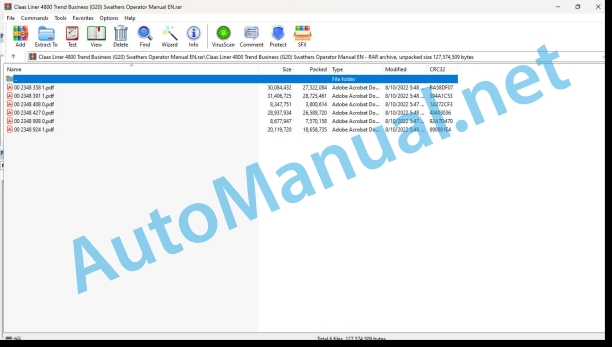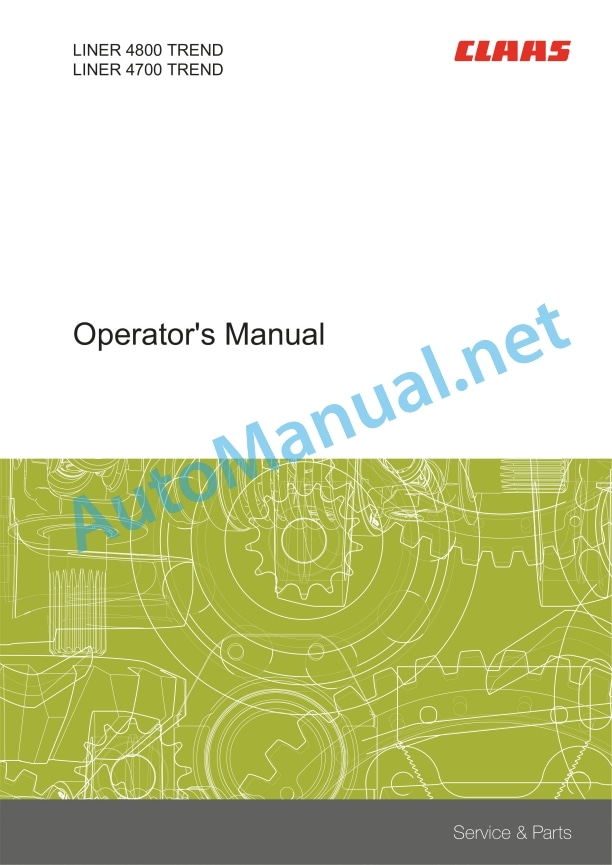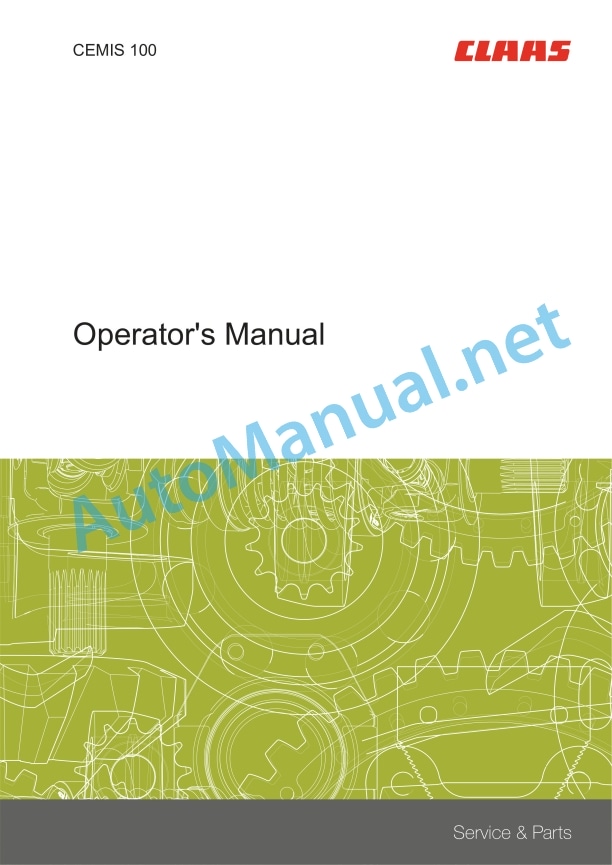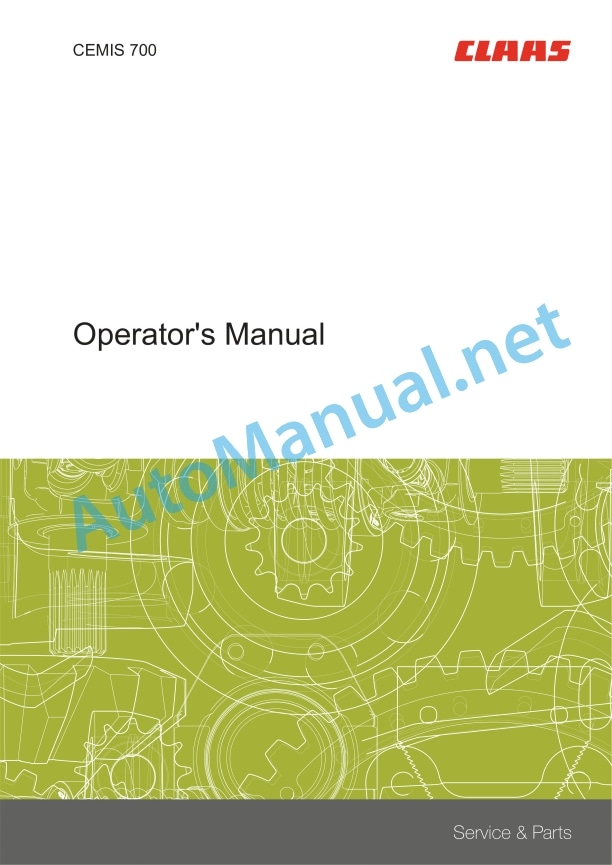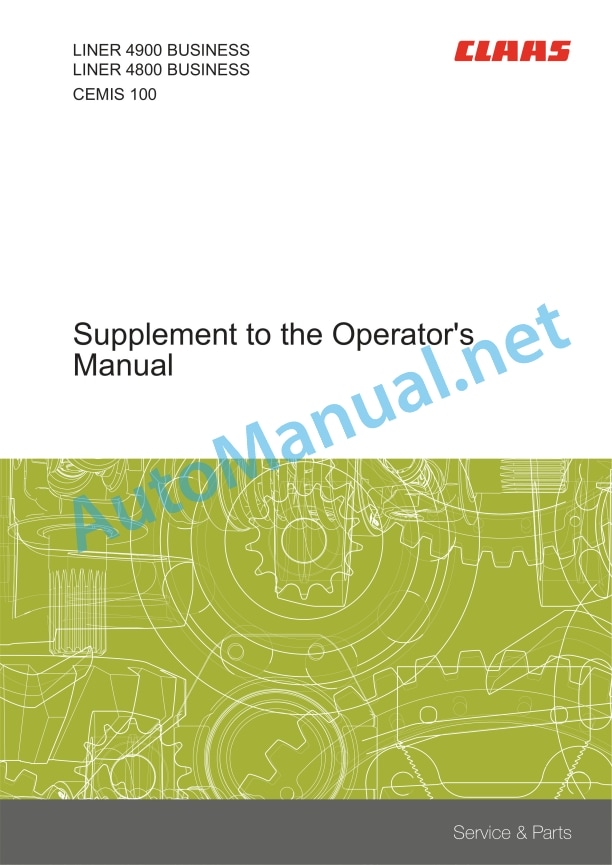Claas Liner 4800 Trend Business (G20) Swathers Operator Manual EN
$50.00
- Model: Liner 4800 Trend Business (G20) Swathers
- Type Of Manual: Operator Manual
- Language: EN
- Format: PDF(s)
- Size: 108 MB
File List:
00 2348 358 1.pdf
00 2348 391 1.pdf
00 2348 408 0.pdf
00 2348 427 0.pdf
00 2348 908 0.pdf
00 2348 924 1.pdf
00 2348 358 1.pdf:
LINER 4900 BUSINESSLINER 4800 BUSINESS
Table of contents
1 Introduction
1.1 Notes on the manual
1.1.1 Validity of the manual
1.1.2 Information about this Operator’s Manual
1.1.3 Symbols and notes
1.1.4 Optional equipment
1.1.5 Qualified specialist workshop
1.1.6 Warranty notes
1.1.7 Spare parts and technical questions
1.2 Intended use
1.2.1 Intended use
1.2.2 Reasonably foreseeable misuse
2 Safety
2.1 Identifying warnings
2.1.1 Hazard signs
2.1.2 Signal word
2.2 Safety rules
2.2.1 Importance of Operator’s Manual
2.2.2 Observing safety decals and warnings
2.2.3 Requirements for all persons working with the machine
2.2.4 Children in danger
2.2.5 Hazard areas
2.2.6 Presence between tractor and machine
2.2.7 Persons riding on the machine
2.2.8 Hitching the tractor to the machine
2.2.9 Danger of injury from rotating shafts
2.2.10 Structural alterations
2.2.11 Optional equipment and spare parts
2.2.12 Control of the machine while it is running
2.2.13 Only use once properly put into operation
2.2.14 Technical condition
2.2.15 Danger from damage to the machine
2.2.16 Complying with technical limit values
2.2.17 Danger from continued running of machine parts
2.2.18 Keeping safety devices functional
2.2.19 Personal protective equipment
2.2.20 Wearing suitable clothing
2.2.21 Removing dirt and loose objects
2.2.22 Preparing the machine for road travel
2.2.23 Risks when driving on the road and in the field
2.2.24 Parking the machine safely
2.2.25 Unsupervised parking
2.2.26 Unsuitable operating utilities
2.2.27 Safe handling of operating and auxiliary utilities
2.2.28 Environmental protection and disposal
2.2.29 Fire prevention
2.2.30 Lethal electrocution from overhead lines
2.2.31 Behaviour in case of voltage flash-over from overhead lines and when lightning strikes
2.2.32 Pressurised fluids
2.2.33 Hot surfaces
2.2.34 Working on machine only after shutting it down
2.2.35 Maintenance work and repairs
2.2.36 Raised machine parts and loads
2.2.37 Danger from welding work
2.3 Safety marking
2.3.1 Structure of safety decals
2.3.2 Safety decals on the machine
3 Machine description
3.1 Overview and method of operation
3.1.1 Machine overview
3.1.2 Function of machine
3.2 Optional equipment
3.2.1 Speed signal cable*
3.2.2 ISOBUS connecting cable*
3.2.3 Battery cable*
3.2.4 Brake pressure regulator*
3.2.5 Work lighting*
3.2.6 Swath guard*
3.2.7 Tine bar bracket*
3.2.8 Spare wheel*
3.3 Identification plates and identification numbers
3.3.1 Machine identification plate
3.4 Information on the machine
3.4.1 Stickers on the machine
4 Operating and display elements
4.1 Controls
4.1.1 Parking brake*
4.1.2 Stand
4.1.3 Raking height crank*
4.1.4 CEMIS 700* control terminal
4.1.5 CEMIS 100* control terminal
4.2 Display elements
4.2.1 Steering angle indicator
4.2.2 Raking height scale
5 Technical specifications
5.1 LINER 4900 BUSINESS
5.1.1 Dimensions
5.1.2 Weights
5.1.3 Requirements for the tractor
5.1.4 Version
5.1.5 Tyre pressure
5.1.6 Lubricants
5.2 LINER 4800 BUSINESS
5.2.1 Dimensions
5.2.2 Weights
5.2.3 Requirements for the tractor
5.2.4 Version
5.2.5 Tyre pressure
5.2.6 Lubricants
6 Machine preparation
6.1 Switching off and securing the machine
6.1.1 Switching off and securing the tractor and machine
6.1.2 Securing the raised machine
6.2 Adapting the tractor
6.2.1 Front axle ballast
6.2.2 Checking the protective guard on the tractor PTO shaft
6.2.3 Installing CEMIS 100*
6.2.4 Installing CEMIS 700*
6.3 Adapting the machine
6.3.1 Checking the universal drive shaft length
6.3.2 Adapting the universal drive shaft length
6.3.3 Fitting the universal drive shaft to the machine
6.3.4 Adapting the hydraulic system
Closed hydraulic system (constant-pressure or load sensing)
Open hydraulic system
Position of Load Sensing hydraulic connection
6.4 Hitching the machine
6.4.1 Removing the safety lock*
6.4.2 Hitching up the hitch bracket
Secure the lower link hooks to prevent them from being opened unintentionally
6.4.3 Installing the universal drive shaft
6.4.4 Connecting the hydraulic hose lines
6.4.5 Connecting the compressed air brake*
6.4.6 Connecting the hydraulic brake*
6.4.7 Connecting the lighting cable
6.4.8 Connecting CEMIS* to a tractor without an ISOBUS socket
6.4.9 Connecting CEMIS* to a tractor with an ISOBUS socket
6.4.10 Connecting the battery cable*
6.4.11 Swinging up the stand
6.4.12 Releasing the parking brake*
6.4.13 Removing the wheel chocks
6.5 Unhitching the machine
6.5.1 Parking the machine safely
6.5.2 Folding in the lighting bracket
6.5.3 Positioning the wheel chock at the wheel
6.5.4 Applying the parking brake*
6.5.5 Swinging the stand down
6.5.6 Disconnecting the lighting cable
6.5.7 Disconnecting CEMIS*
6.5.8 Disconnecting the compressed-air brake*
6.5.9 Disconnecting the hydraulic brake*
6.5.10 Disconnecting the hydraulic hoses
6.5.11 Removing the universal drive shaft
6.5.12 Unhitching headstock
6.5.13 Attaching the safety lock*
6.6 Prepare road travel
6.6.1 Folding out the lighting bracket
6.6.2 Folding the machine into the transport position
6.6.3 Fitting the protection strips
6.6.4 Performing checks prior to road travel
6.7 Preparing fieldwork
6.7.1 Removing protection strips
6.7.2 Folding the machine to the working position
6.8 Loading the machine
6.8.1 Manoeuvring the machine
Manoeuvering with tractors without a compressed-air system
6.8.2 Lifting the machine
7 Operation
7.1 Driving on the road
7.1.1 Adjusting the transport height
7.1.2 Driving on public roads
7.2 Fieldwork settings
7.2.1 Adjusting the longitudinal frame
7.2.2 Setting the inclination of rotors
Basic setup
Setting for heavy fodder or high fodder mass
Maximum adjustment
7.2.3 Adjusting the raking height
Adjusting the raking height with CEMIS*
Adjusting the raking height with the crank*
7.2.4 Adjusting the swath guard*
Adjusting the swath guard height
Swathing without swath guard
Locking the swath guard
Unlocking the swath guard
7.3 Fieldwork
7.3.1 Operating the machine with CEMIS 700 or CEMIS 100
7.3.2 Folding the machine into the transport position
7.3.3 Folding the machine to the working position
7.3.4 Lifting the swathing rotors to the headland position
7.3.5 Adjusting the working width and swath width
7.3.6 Individual rotor lift
7.3.7 Machine use
7.3.8 Adapting the PTO shaft speed
8 Faults and remedies
8.1 Chassis
8.1.1 Main chassis problems
8.1.2 Changing a wheel on the main chassis
8.1.3 Changing a gauge wheel
8.2 Electric system
8.2.1 Lighting equipment defective
8.2.2 Work light* defective
9 Maintenance
9.1 Maintenance interval overview
9.1.1 Before the harvest
9.1.2 After the first 10 operating hours
9.1.3 After the first 50 operating hours
9.1.4 Every 8 operating hours or daily
9.1.5 Every 50 operating hours
9.1.6 Every 100 operating hours
9.1.7 Every 250 operating hours or annually
9.1.8 Every 500 operating hours or annually
9.1.9 Every 2 years
9.1.10 After the harvest
9.2 Gearbox
9.2.1 Checking the gearbox for leaks
9.2.2 Checking the oil level in the front transfer gearbox
9.2.3 Changing the oil in the front transfer gearbox
9.2.4 Checking the oil level in the rear transfer gearbox
9.2.5 Changing the oil in the rear transfer gearbox
9.2.6 Checking the oil level in the angle drive
9.2.7 Change the oil in the angle drive
9.2.8 Check the oil level in the swath gearbox
9.2.9 Changing the oil in the swath gearbox
9.2.10 Checking the swathing gearbox bolts
9.3 Clutch
9.3.1 Check the clutch
9.3.2 Venting the friction clutch
9.3.3 Cleaning the clutch
9.4 Universal drive shaft
9.4.1 Servicing the universal drive shafts
9.4.2 Checking the universal drive shaft nuts
9.5 Chassis
9.5.1 Check the tyre pressure
9.5.2 Checking the wheel axle fastenings
9.5.3 Checking the wheel nuts on the main chassis
9.5.4 Checking the wheel nuts on the swathing rotor chassis
9.5.5 Checking the stop bolts on the 4-wheel swathing rotor chassis
9.5.6 Checking the stop bolts on the 6-wheel swathing rotor chassis
9.6 Brake
9.6.1 Checking the brake system*
9.6.2 Drain the compressed air reservoir*
9.6.3 Clean the pipe filter*
9.6.4 Adjusting the compressed-air brake slack adjusters*
9.6.5 Checking the drilled holes of brake cylinders*
9.7 Hydraulic system
9.7.1 Replacing the hydraulic oil filter
9.7.2 Checking the hydraulic hoses
9.8 Rotor
9.8.1 Checking the threaded joints of the swathing rotors
9.8.2 Checking the compression springs
9.8.3 Apply oil to the tine bar profile
9.8.4 Checking the spring brackets
9.8.5 Checking the tines
9.8.6 Checking the lamellar plugs
9.9 Assembly parts and machine body
9.9.1 Checking the bolted joints of hitching bracket
9.9.2 Checking the threaded joints of the frame
9.9.3 Remove any crop residues
9.9.4 Clean the machine
9.9.5 Preserve the machine
9.9.6 Preventing frost damage
9.9.7 Check the fittings
9.10 Lubrication plan
9.10.1 Lubricate lubrication points every 50 operating hours
9.10.2 Lubricating grease points every 100 operating hours
9.10.3 Lubricating grease points every 250 operating hours
10 Putting out of operation and disposal
10.1 General information
10.1.1 Removal from service and disposal
11 EC declaration of conformity
11.1 LINER 4900/4800 BUSINESS
11.1.1 UK declaration of conformity
11.1.2 EC declaration of conformity
12 Technical terms and abbreviations
12.1 Terms and explanations
12.1.1 Technical terms
12.1.2 Abbreviations
00 2348 391 1.pdf:
LINER 4800 TRENDLINER 4700 TREND
Table of contents
1 Introduction
1.1 Notes on the manual
1.1.1 Validity of the manual
1.1.2 Information about this Operator’s Manual
1.1.3 Symbols and notes
1.1.4 Optional equipment
1.1.5 Qualified specialist workshop
1.1.6 Warranty notes
1.1.7 Spare parts and technical questions
1.2 Intended use
1.2.1 Intended use
1.2.2 Reasonably foreseeable misuse
2 Safety
2.1 Identifying warnings
2.1.1 Hazard signs
2.1.2 Signal word
2.2 Safety rules
2.2.1 Importance of Operator’s Manual
2.2.2 Observing safety decals and warnings
2.2.3 Requirements for all persons working with the machine
2.2.4 Children in danger
2.2.5 Hazard areas
2.2.6 Presence between tractor and machine
2.2.7 Persons riding on the machine
2.2.8 Hitching the tractor to the machine
2.2.9 Danger of injury from rotating shafts
2.2.10 Structural alterations
2.2.11 Optional equipment and spare parts
2.2.12 Control of the machine while it is running
2.2.13 Only use once properly put into operation
2.2.14 Technical condition
2.2.15 Danger from damage to the machine
2.2.16 Complying with technical limit values
2.2.17 Danger from continued running of machine parts
2.2.18 Keeping safety devices functional
2.2.19 Personal protective equipment
2.2.20 Wearing suitable clothing
2.2.21 Removing dirt and loose objects
2.2.22 Preparing the machine for road travel
2.2.23 Risks when driving on the road and in the field
2.2.24 Parking the machine safely
2.2.25 Unsupervised parking
2.2.26 Unsuitable operating utilities
2.2.27 Safe handling of operating and auxiliary utilities
2.2.28 Environmental protection and disposal
2.2.29 Fire prevention
2.2.30 Lethal electrocution from overhead lines
2.2.31 Behaviour in case of voltage flash-over from overhead lines and when lightning strikes
2.2.32 Pressurised fluids
2.2.33 Hot surfaces
2.2.34 Working on machine only after shutting it down
2.2.35 Maintenance work and repairs
2.2.36 Raised machine parts and loads
2.2.37 Danger from welding work
2.3 Safety marking
2.3.1 Structure of safety decals
2.3.2 Safety decals on the machine
3 Machine description
3.1 Overview and method of operation
3.1.1 Machine overview
3.1.2 Function of machine
3.2 Optional equipment
3.2.1 Brake pressure regulator*
3.2.2 Hydraulic sequential control*
3.2.3 Individual lifting function*
3.2.4 Swath guard*
3.2.5 Tine bar bracket*
3.2.6 Spare wheel*
3.3 Identification plates and identification numbers
3.3.1 Machine identification plate
3.4 Information on the machine
3.4.1 Stickers on the machine
4 Operating and display elements
4.1 Controls
4.1.1 Parking brake*
4.1.2 Shut-off tap
4.1.3 Stand
4.1.4 Raking height crank
4.2 Display elements
4.2.1 Arrows
4.2.2 Steering angle indicator
4.2.3 Raking height scale
5 Technical specifications
5.1 LINER 4800 TREND
5.1.1 Dimensions
5.1.2 Weights
5.1.3 Requirements for the tractor
5.1.4 Version
5.1.5 Tyre pressure
5.1.6 Lubricants
5.2 LINER 4700 TREND
5.2.1 Dimensions
5.2.2 Weights
5.2.3 Requirements for the tractor
5.2.4 Version
5.2.5 Tyre pressure
5.2.6 Lubricants
6 Machine preparation
6.1 Switching off and securing the machine
6.1.1 Switching off and securing the tractor and machine
6.1.2 Securing the raised machine
6.2 Adapting the tractor
6.2.1 Front axle ballast
6.2.2 Checking the protective guard on the tractor PTO shaft
6.3 Adapting the machine
6.3.1 Checking the universal drive shaft length
6.3.2 Adapting the universal drive shaft length
6.3.3 Fitting the universal drive shaft to the machine
6.4 Hitching the machine
6.4.1 Removing the safety lock*
6.4.2 Hitching up the hitch bracket
Secure the lower link hooks to prevent them from being opened unintentionally
6.4.3 Installing the universal drive shaft
6.4.4 Laying the pull rope
6.4.5 Connecting the hydraulic hoses, without individual lifting function*
Overview of hydraulic clutches
Connecting the hydraulic hoses for lifting and lowering the front swathing rotors and the main chassis
Connecting the hydraulic hoses for extending and retracting the front rotors
Connecting the hydraulic hose for lifting the rear rotors
6.4.6 Connecting the hydraulic hoses, with individual lifting function*
Overview of hydraulic couplings with individual lifting function*
Connecting the hydraulic hoses for lifting and lowering the front swathing rotors and the main chassis
Connecting the hydraulic hoses for extending and retracting the front rotors
Connecting the hydraulic hoses for lifting the rear swathing rotors
Connect the hydraulic hose for lifting the front right swathing rotor
6.4.7 Connecting the compressed air brake*
6.4.8 Connecting the hydraulic brake*
6.4.9 Connecting the lighting cable
6.4.10 Swinging up the stand
6.4.11 Releasing the parking brake*
6.4.12 Removing the wheel chocks
6.5 Unhitching the machine
6.5.1 Parking the machine safely
6.5.2 Folding in the lighting bracket
6.5.3 Positioning the wheel chock at the wheel
6.5.4 Applying the parking brake*
6.5.5 Swinging the stand down
6.5.6 Disconnecting the lighting cable
6.5.7 Disconnecting the compressed-air brake*
6.5.8 Disconnecting the hydraulic brake*
6.5.9 Disconnecting the hydraulic hoses, without individual lifting function*
6.5.10 Disconnecting the hydraulic hoses, with individual lifting function*
6.5.11 Removing the pull rope
6.5.12 Removing the universal drive shaft
6.5.13 Unhitching headstock
6.5.14 Attaching the safety lock*
6.6 Prepare road travel
6.6.1 Folding out the lighting bracket
6.6.2 Folding the machine into the transport position
6.6.3 Closing the shut-off tap
6.6.4 Fitting the protection strips
6.6.5 Performing checks prior to road travel
6.7 Preparing fieldwork
6.7.1 Removing protection strips
6.7.2 Opening the shut-off tap
6.7.3 Folding the machine to the working position
6.8 Loading the machine
6.8.1 Manoeuvring the machine
Manoeuvering with tractors without a compressed-air system
6.8.2 Lifting the machine
7 Operation
7.1 Driving on the road
7.1.1 Adjusting the transport height
7.1.2 Driving on public roads
7.2 Fieldwork settings
7.2.1 Adjusting the longitudinal frame
7.2.2 Adjusting the swath width
Adjusting the swathing width in basic position
Conversion to maximum swathing width
Adjustment after the conversion to maximum swathing width
7.2.3 Setting the inclination of rotors
Basic setup
Setting for heavy fodder or high fodder mass
Maximum adjustment
7.2.4 Adjusting the raking height
7.2.5 Setting the turning area height
7.2.6 Adjusting the hydraulic sequential control*
Setting the delay time while lifting
Setting the delay time while lowering
Deactivating hydraulic sequential control
7.2.7 Adjusting the swath guard*
Adjusting the swath guard height
Swathing without swath guard
Locking the swath guard
Unlocking the swath guard
7.3 Fieldwork
7.3.1 Retracting and extending the main chassis
7.3.2 Folding the machine into the transport position
7.3.3 Folding the machine to the working position
7.3.4 Lifting the swathing rotors to the headland position
7.3.5 Setting the working width
7.3.6 Machine use
7.3.7 Adapting the PTO shaft speed
7.4 CEMIS 10
7.4.1 CEMIS 10 recommendations
7.5 Switching the CEMIS 10 on and off
7.5.1 Switching on the terminal
7.5.2 Switching off the terminal
7.6 CEMIS 10 transport position
7.6.1 Folding the machine into the transport position
7.7 CEMIS 10 working position
7.7.1 Folding the machine to the working position
7.8 CEMIS 10 individual lifting function with one control valve
7.8.1 Lifting the front swathing rotors individually
7.8.2 Lowering the front swathing rotors individually
7.9 CEMIS 10 individual lifting function with two control valves
7.9.1 Operation with two control valves
8 Faults and remedies
8.1 Chassis
8.1.1 Main chassis problems
8.1.2 Changing a wheel on the main chassis
8.1.3 Changing a gauge wheel
8.2 Electric system
8.2.1 Lighting equipment defective
9 Maintenance
9.1 Maintenance interval overview
9.1.1 Before the harvest
9.1.2 After the first 10 operating hours
9.1.3 After the first 50 operating hours
9.1.4 Every 8 operating hours or daily
9.1.5 Every 50 operating hours
9.1.6 Every 100 operating hours
9.1.7 Every 250 operating hours or annually
9.1.8 Every 500 operating hours or annually
9.1.9 Every 2 years
9.1.10 After the harvest
9.2 Gearbox
9.2.1 Checking the gearbox for leaks
9.2.2 Checking the oil level in the front transfer gearbox
9.2.3 Changing the oil in the front transfer gearbox
9.2.4 Checking the oil level in the rear transfer gearbox
9.2.5 Changing the oil in the rear transfer gearbox
9.2.6 Checking the oil level in the angle drive
9.2.7 Change the oil in the angle drive
9.2.8 Check the oil level in the swath gearbox
9.2.9 Changing the oil in the swath gearbox
9.2.10 Checking the swathing gearbox bolts
9.3 Clutch
9.3.1 Check the clutch
9.3.2 Venting the friction clutch
9.3.3 Cleaning the clutch
9.4 Universal drive shaft
9.4.1 Servicing the universal drive shafts
9.4.2 Checking the universal drive shaft nuts
9.5 Chassis
9.5.1 Check the tyre pressure
9.5.2 Checking the wheel axle fastenings
9.5.3 Checking the wheel nuts on the main chassis
9.5.4 Checking the wheel nuts on the swathing rotor chassis
9.5.5 Checking the stop bolts on the 4-wheel swathing rotor chassis
9.5.6 Checking the stop bolts on the 6-wheel swathing rotor chassis
9.6 Brake
9.6.1 Checking the brake system*
9.6.2 Drain the compressed air reservoir*
9.6.3 Clean the pipe filter*
9.6.4 Adjusting the compressed-air brake slack adjusters*
9.6.5 Checking the drilled holes of brake cylinders*
9.7 Hydraulic system
9.7.1 Replacing the hydraulic oil filter
9.7.2 Checking the hydraulic hoses
9.8 Rotor
9.8.1 Checking the threaded joints of the swathing rotors
9.8.2 Checking the compression springs
9.8.3 Apply oil to the tine bar profile
9.8.4 Checking the spring brackets
9.8.5 Checking the tines
9.8.6 Checking the lamellar plugs
9.9 Assembly parts and machine body
9.9.1 Checking the bolted joints of hitching bracket
9.9.2 Checking the threaded joints of the frame
9.9.3 Remove any crop residues
9.9.4 Clean the machine
9.9.5 Preserve the machine
9.9.6 Preventing frost damage
9.9.7 Check the fittings
9.10 Lubrication plan
9.10.1 Lubricate lubrication points every 50 operating hours
9.10.2 Lubricating grease points every 100 operating hours
9.10.3 Lubricating grease points every 250 operating hours
10 Putting out of operation and disposal
10.1 General information
10.1.1 Removal from service and disposal
11 Declaration of Conformity
11.1 LINER 4800/4700 TREND
11.1.1 UK declaration of conformity
11.1.2 EC declaration of conformity
12 Technical terms and abbreviations
12.1 Terms and explanations
12.1.1 Technical terms
12.1.2 Abbreviations
00 2348 408 0.pdf:
CEMIS 100
Table of contents
1 Introduction
1.1 General information
1.1.1 Validity of the manual
1.1.2 Information about this Operator’s Manual
1.1.3 Symbols and notes
1.2 Intended use
1.2.1 Intended use
1.2.2 Reasonably foreseeable misuse
2 Safety
2.1 Safety rules
2.1.1 General safety and accident prevention regulations
2.1.2 Interaction between terminal and machine or tractor
2.1.3 Electrocution by electrical system
3 Product description
3.1 Overview and method of operation
3.1.1 Overview of CEMIS 100
3.1.2 Function principle of CEMIS 100
3.2 Identification plates and identification numbers
3.2.1 Spare parts and technical questions
3.2.2 Identification plate of CEMIS 100
4 Operating and display elements
4.1 CEMIS 100
4.1.1 User interface for LINER
4.1.2 User interface for ROLLANT
4.1.3 User interface for UNIWRAP
5 Technical specifications
5.1 CEMIS 100
5.1.1 Specification
6 Operation
6.1 CEMIS 100
6.1.1 Operating the CEMIS 100
6.1.2 Switching CEMIS 100 on
6.1.3 Switching CEMIS 100 off
7 Maintenance
7.1 CEMIS 100
7.1.1 Daily
8 Putting out of operation and disposal
8.1 General information
8.1.1 Removal from service and disposal
9 Technical terms and abbreviations
9.1 Terms and explanations
9.1.1 Technical words
9.1.2 Abbreviations
00 2348 427 0.pdf:
CEMIS 700
Table of contents
1 Introduction
1.1 General information
1.1.1 Validity of the manual
1.1.2 Information about this Operator’s Manual
1.1.3 Symbols and notes
1.2 Intended use
1.2.1 Intended use
1.2.2 Reasonably foreseeable misuse
2 Safety
2.1 Safety rules
2.1.1 General safety and accident prevention regulations
2.1.2 Interaction between terminal and machine or tractor
2.1.3 Electrocution by electrical system
3 Product description
3.1 Overview and method of operation
3.1.1 Overview of CEMIS 700
3.1.2 Function principle of CEMIS 700
3.2 Identification plates and identification numbers
3.2.1 Spare parts and technical questions
3.2.2 Identification plate of CEMIS 700
4 Information on the product
4.1 Software version
5 Operating and display elements
5.1 CEMIS 700
5.1.1 User interface
5.1.2 Terminal program
6 Technical specifications
6.1 CEMIS 700
6.1.1 Specification
7 Operation
7.1 CEMIS 700
7.1.1 Operating the CEMIS 700
7.1.2 Switching CEMIS 700 on
7.1.3 Switching CEMIS 700 off
7.2 Terminal settings
7.2.1 Making settings
Making settings with the rotary button
Making settings with the touch function
7.2.2 Setting the screen lighting
Daytime mode
Nighttime mode
Activating automatic key lighting
7.2.3 Setting the time and date
7.2.4 Displaying diagnosis information
On-board power supply voltage display
Display of CLAAS ISOBUS ECU address and name
7.2.5 Setting the language and display formats
Setting the language
Setting display formats
7.2.6 Setting the volume
7.2.7 Deleting an ISOBUS implement
8 Maintenance
8.1 Maintenance
8.1.1 Daily
9 Putting out of operation and disposal
9.1 General information
9.1.1 Removal from service and disposal
10 Technical terms and abbreviations
10.1 Terms and explanations
10.1.1 Technical words
10.1.2 Abbreviations
00 2348 908 0.pdf:
LINER 4900 BUSINESSLINER 4800 BUSINESSCEMIS 100
Table of contents
1 Introduction
1.1 Notes on the manual
1.1.1 Validity of the manual
1.2 Intended use
1.2.1 Intended use
1.2.2 Reasonably foreseeable misuse
2 Safety
2.1 Safety rules
2.1.1 General safety and accident prevention regulations
2.1.2 Interaction between terminal and machine or tractor
2.1.3 Electrocution by electrical system
3 Product description
3.1 Overview and method of operation
3.1.1 Overview of CEMIS 100
3.2 Identification plates and identification numbers
3.2.1 Spare parts and technical questions
3.2.2 Identification plate of CEMIS 100
4 Technical specifications
4.1 CEMIS 100
4.1.1 Specification
5 Operation
5.1 Overview
5.1.1 Menus
5.1.2 Keys
5.1.3 LEDs
5.2 Switching the terminal on and off
5.2.1 Switching on the terminal
5.2.2 Switching off the terminal
5.3
5.3.1 Folding the machine to the working position
5.3.2 Folding the machine into the transport position
5.3.3 Lifting and lowering the chassis
5.3.4 Switching the worklights on and off
5.4
5.4.1 Selecting the
5.4.2 Automatic function
5.4.3 Manually controlled delay time
5.4.4 Individual rotor lift
5.4.5 Removing and re-integrating rotors from/into the automatic function
5.4.6 Changing the working width
5.4.7 Setting the headland heights
5.4.8 Setting the delay times
5.4.9 Manual operation
5.4.10 Starting, stopping and deleting the hectare counter
5.5
5.5.1 Adjusting the working width and swath width
5.6 Raking height menu
5.6.1 Adjusting the raking height
5.7
5.7.1 Displaying sensor values and CCN
5.7.2 Setting the backlight and the volume
5.7.3 Switching the worklights on and off
5.8 Basic setting (Initialise)
5.8.1 General instructions
5.8.2 Learning the rotor end stops
5.8.3 Learning the chassis limit stops
5.8.4 Learning the working width / swathing width end stops
5.8.5 Learning the raking height end stops
6 Faults and remedies
6.1 Sensor fault
6.1.1 Folding the machine to the working position
6.1.2 Folding the machine into the transport position
7 Maintenance
7.1 CEMIS 100
7.1.1 Daily
00 2348 924 1.pdf:
LINER 4900 BUSINESSLINER 4800 BUSINESSCEMIS 700
Table of contents
1 Introduction
1.1 General information
1.1.1 Validity of the manual
1.2 Intended use
1.2.1 Intended use
1.2.2 Reasonably foreseeable misuse
2 Safety
2.1 Safety rules
2.1.1 General safety and accident prevention regulations
2.1.2 Interaction between terminal and machine or tractor
2.1.3 Electrocution by electrical system
3 Product description
3.1 Overview and method of operation
3.1.1 Overview of CEMIS 700
3.1.2 User interface
3.1.3 Terminal program
3.2 Identification plates and identification numbers
3.2.1 Spare parts and technical questions
3.2.2 Identification plate of CEMIS 700
3.2.3 Software version
4 Technical specifications
4.1 CEMIS 700
4.1.1 Specification
5 Operation
5.1 Overview
5.1.1 Display
5.1.2
5.1.3
5.1.4
5.1.5 Settings menu
5.1.6
5.1.7
5.1.8
5.1.9
5.2 Operating the terminal
5.2.1 Switching on the terminal
5.2.2 Switching off the terminal
5.2.3 Calling up the menu and menu exit
5.3
5.3.1 Folding out the machine to the working position
5.3.2 Folding the machine to transport position
5.3.3 Lifting and lowering the chassis
5.3.4 Switching the worklights on and off
5.4
5.4.1 Calling up the
5.4.2 Automatic function
5.4.3 Controlling the delay manually
5.4.4 Individual rotor lift
5.4.5 Removing and re-integrating rotors from/into the automatic function
5.4.6 Changing the working width
Changing the working width on one side only
Increases the working width
Reduces the working width
Exit individual selection
5.4.7 Changing the swath width
5.4.8 Changing the raking height*
5.4.9 Manual operation
5.5
5.5.1 Calling up the
5.5.2 Setting the headland heights
5.5.3 Setting the delay
5.5.4 Setting the working width
5.5.5 Adjusting the swath width
5.5.6 Adjusting the overlap
5.5.7 Adjust the chassis
5.5.8 Setting the raking height*
5.5.9 Engaging and disengaging the automatic reversing mode
5.6
5.6.1 Calling up the
5.6.2 Creating, editing, deleting a job
5.6.3 Switching data entry on and off
5.7
5.7.1 Calling up the
5.7.2 Viewing the sensor values
5.7.3 Restoring the factory settings
Factory settings
5.8 Manual operation
5.8.1 Calling up the
5.8.2 Lifting and lowering the rotors
5.8.3 Increasing and reducing the working width / swathing width
5.8.4 Lifting and lowering the chassis
5.8.5 Increasing and reducing the raking height*
5.8.6 Opening and closing the lock
5.9 Basic setting (Initialise)
5.9.1 General instructions
5.9.2 Voltage range for plausibility check
5.9.3 Calling up the
5.9.4 Learning the chassis limit stops
5.9.5 Teaching-in the raking height* end stops
5.9.6 Learning the working width / swathing width end stops
5.9.7 Learning the rotor end stops
5.10 ISOBUS
5.10.1 Available functions
5.10.2 Example of a CLAAS tractor application
ELECTROPILOT four-way control lever
CMOTION multifunction lever
5.10.3 Application examples of FENDT tractors
FENDT Vario joystick
6 Faults and remedies
6.1 Control unit, fault messages
6.1.1 Warning messages
6.1.2 Fault messages
6.1.3 Fault code table
6.2 Sensor fault
6.2.1 Folding out the machine manually
6.2.2 Folding in the machine manually
7 Maintenance
7.1 CEMIS 700
7.1.1 Daily
John Deere Repair Technical Manual PDF
John Deere Repair Technical Manual PDF
John Deere Repair Technical Manual PDF
John Deere Repair Technical Manual PDF
John Deere 18-Speed PST Repair Manual Component Technical Manual CTM168 10DEC07
John Deere Repair Technical Manual PDF
John Deere Parts Catalog PDF
John Deere Harvesters 8500 and 8700 Parts Catalog CPCQ24910 Spanish
John Deere Repair Technical Manual PDF
John Deere Repair Technical Manual PDF
John Deere Repair Technical Manual PDF
John Deere Transmission Control Unit Component Technical Manual CTM157 15JUL05
John Deere Repair Technical Manual PDF

